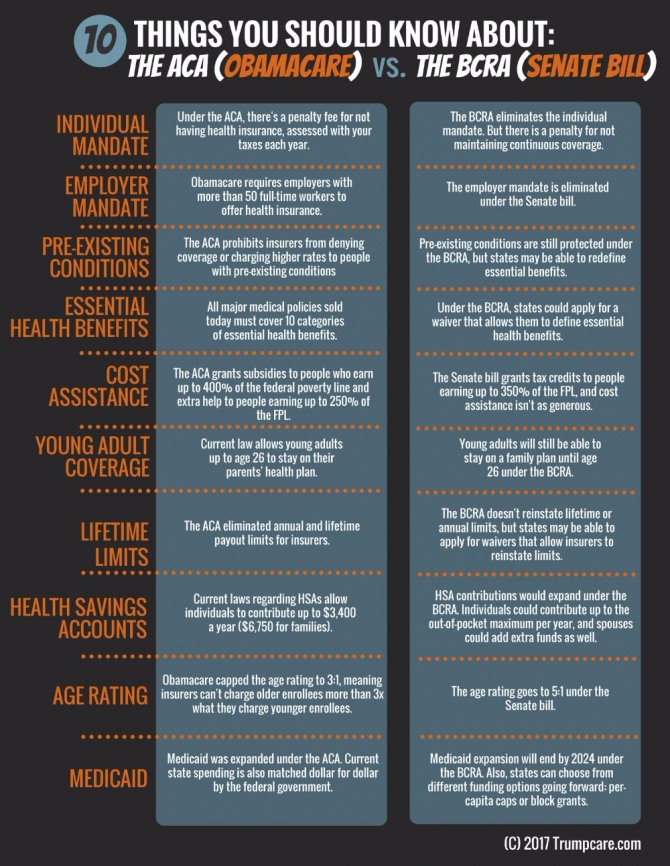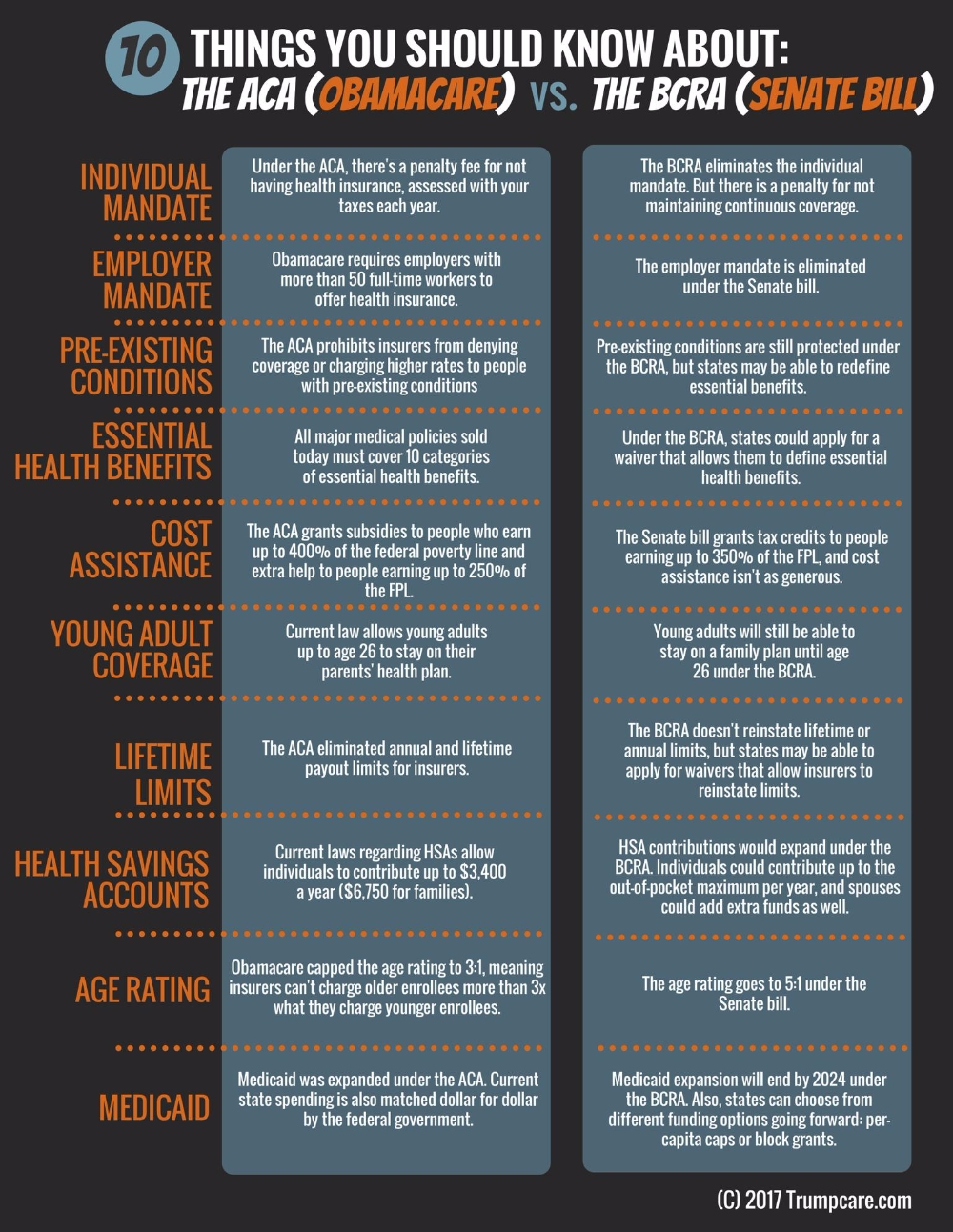 이미지 확대보기
이미지 확대보기백악관은 19일 트럼프 대통령이 추진해 왔던 의료보험제도인 트럼프 케어가 여당인 공화당 내부 반발로 더 이상 추진할 수 없게 됐다고 밝혔다.
트럼프 케어는 하원을 통과한 다음 상원 계류 중이었다.
현재 상원의 의석 분포는 공화당이 전체100석중 52석을 차지하고 있어 공화당만으로도 통과가 가능했다.
민주당 소속 상원의원 48명은 전원 트럼프케어에 반대하고있다.
도널드 트럼프 대통령은 공화당의 반대가 알려진 후 트럼프 케어 통과 계획을 일단 접고 오바마케어를 폐지쪽으로 방향을 선화한다고 밝혔다.
트럼프케어 통과무산으로 미국 경제에는 적지 않은 후폭풍이 예상된다.
다음은 트럼프 행정부가 마련한 오바마케어와 트럼프 케어 비교
Obamacare vs. Trumpcare (BCRA)
We will be updating the table in the previous update to reflect the new proposed changes under the Senate version of the Trumpcare (BCRA). This latest version at the outset has some provisions that will be popular with Americans. However, there are still going to be millions of deeply concerned families who rely on Medicaid for care. Below we get into all of the details concerning this latest effort to get Trumpcare to a vote with the Senate.
The Senate released proposed amendments to their version of the healthcare bill, Better Care Reconciliation Act, on July 13th. These amendments were supposed to incorporate concepts and ideals requested by all sides of Republican party. The amendments to the bill are:
The BCRA allows insurers to offer plans to the public that don’t meet the requirements of Obamacare, meaning that they don’t cover pre-existing conditions and include the ten essential benefits, so long as they offer one plan to the public that does meet all of the requirements of Obamacare. The BCRA amendment would provide money to the insurers from a fund to help offset the costs of these higher risk individuals who have pre-existing conditions.
This amendment was introduced by Senators Ted Cruz (R-TX) and Mike Lee (R-UT) and has been controversial amongst other members who are concerned that it will not leave enough options for people who have pre-existing conditions or who want a fuller plan with more coverage options. In order to satisfy those concerns, the amendment also includes additional financial assistance for people who do need a plan that covers pre-existing conditions.
Insurers are not entirely behind this amendment because they believe that by essentially creating one set of plans for sick people (Obamacare-compliant plans) and one set that will be attractive to healthy people because they will be cheaper, but have less benefits, it will make the Obamacare plans unaffordable for consumers because the healthy people won’t be buying them as well and insurance carriers will still leave the marketplace.
Insurance carriers can’t make any kind of a profit from a risk pool that does not have a higher percentage of healthy individuals within it to offset the funds that will be paid out to provide costly care to individual with health problems. That’s just how health insurance works, it’s really that simple.
The Medicaid roll back schedule proposed in the original BCRA language remains the same in the amendment, meaning that funding for the program will start to decrease in 2021 until it is restored to pre-Obamacare levels in 2024. Starting in 2020, states can decide whether they want funding for Medicaid based on a block-grant (set amount of money) or per-capita basis (based on number of people) calculation each year and it also allows the states to impose a requirement for people on Medicaid who are not pregnant, disabled or elderly to be employed in order to continue receiving benefits.
The Obamacare taxes will remain in place, which will have an effect on the federal deficit.
The government will continue to make the cost-sharing reduction payments to the insurers until 2020, which is necessary to help stabilize the market.
The individual and employee mandates will be eliminated. The continuous coverage requirement will be in effect in accordance with the first draft of the BCRA.
More money is allotted to help cover the out-of-pocket expenses of consumers. BCRA Amendment proposes an additional $70 billion – with a Grand Total of $182 billion – to go to the creation and implementation of reform efforts to bring down cost of premiums and healthcare expenses including towards Health Savings Accounts (HSA).
BCRA would allow people to use money in their HSA to pay for their premiums. The benefit of an HSA is that the money is not taxed, meaning that if you take a portion of your paycheck and put it in an HSA, you will not have to pay Social Security, Medicare, Federal or State taxes on that money.
BCRA gives an additional $45 billion to the states to combat the opioid crisis. This money would be used for substance abuse treatment and recovery.
People who choose to enroll in a catastrophic plan can get tax credits to help pay for the costs of those plans, which was originally prohibited under Obamacare. Catastrophic plans have high deductibles, smaller networks and less benefits, but are good in case of medical emergencies.
In addition, people can use their tax credit to buy lower-premium health insurance plans that have higher deductibles but allow the person to go to the primary care physician three times a year. These types of plans also limit how much a person can spend out-of-pocket a year.
Updated 7/5/2017
Below is a table that outlines some of the differences between Obamacare, and the latest version of Trumpcare under the Senate, the BCRA. In addition to the table below, there is also a PDF infographic that you can download directly. Feel free to share or republish that document wherever you like, we just ask that you credit Trumpcare.com as the source for the infographic.
The List: The ACA (Obamacare) The BCRA (Senate Bill)
INDIVIDUAL MANDATE Under the ACA, there’s a penalty fee for not having health insurance, assessed with your taxes each year. The BCRA eliminates the individual mandate. There is a penalty of a 30% increase in premiums for one year for not maintaining continuous coverage.
EMPLOYER MANDATE Obamacare requires employers with more than 50 full-time workers to offer health insurance. The employer mandate is eliminated under the Senate bill.
PRE-EXISTING CONDITIONS The ACA prohibits insurers from denying coverage or charging higher rates to people with pre-existing conditions Pre-existing conditions are still protected under the BCRA, but states may be able to redefine essential benefits. In effect consumers are not nearly as protected as under the ACA.
ESSENTIAL HEALTH BENEFITS All major medical policies sold today must cover 10 categories of essential health benefits. Under the BCRA, states could apply for a waiver that allows them to define essential health benefits.
COST ASSISTANCE The ACA grants subsidies to people who earn up to 400% of the federal poverty line and extra help to people earning up to 250% of the FPL. The Senate bill grants tax credits to people earning up to 350% of the FPL, and cost assistance isn’t as generous.
YOUNG ADULT COVERAGE Current law allows young adults up to age 26 to stay on their parents’ health plan. Young adults will still be able to stay on a family plan until age 26 under the BCRA.
LIFETIME LIMITS The ACA eliminated annual and lifetime payout limits for insurers. The BCRA doesn’t reinstate lifetime or annual limits, but states may be able to apply for waivers that allow insurers to reinstate limits.
HEALTH SAVINGS ACCOUNTS Current laws regarding HSAs allow individuals to contribute up to $3,400 a year ($6,750 for families). HSA contributions would expand under the BCRA. Individuals could contribute up to the out-of-pocket maximum per year, and spouses could add extra funds as well.
AGE RATING Obamacare capped the age rating to 3:1, meaning insurers can’t charge older enrollees more than 3x what they charge younger enrollees. The age rating goes to 5:1 under the Senate bill.
MEDICAID Medicaid was expanded under the ACA in many states. Current state spending is matched dollar for dollar by the federal government. Medicaid expansion will end by 2024 under the BCRA. Also, states can choose from different funding options going forward: per- capita caps or block grants.
To get a copy of the PDF version below, use this link. Trumpcare.com PDF
Trumpcare BCRA vs Obamacare
Updated 6/27/2017
Age Rating Pricing Under Trumpcare (BCRA – Better Care Act)
Under the Affordable Care Act, insurance companies that participate in the marketplace cannot charge older Americans more than three times what they charge younger Americans. The U.S. Senate proposed a healthcare reform bill last week that would change this rating from 3:1 to 5:1 – an increase of about 67 percent. Known as the Better Care Reconciliation Act of 2017, the Senate healthcare bill would enable insurance companies to charge older Americans five times more for healthcare than their younger counterparts. The common definition of an older American is anyone over the age of 50 or anyone who is near-elderly but doesn’t yet qualify for Medicare.
Senate Bill Allows Insurance Companies to Charge Elderly 5 Times More for Healthcare
Early in 2017, the Republican-controlled House of Representatives passed similar healthcare reform measures that would raise the ratio to 5:1. The bill, known as the American Health Care Act, was unpopular among moderates in the Senate. Healthcare experts had hoped that the upper chamber’s bill would take a more reasonable approach to reform. Several organizations and insurance watchdogs have been deeply opposed to changing the age ratio in particular.
AARP was one of the biggest critics of changing the age ratio to 5:1. Before the enactment of the 3:1 ratio under the ACA, older Americans could not afford health insurance since insurance companies charged near-elderly individuals more money for policies than younger people, according to the organization. Many people between the ages of 50 and 64 are now able to buy coverage due to the 3:1 age ratio under Obamacare. AARP argues that the number of 50- to 64-year-old Americans who went uninsured dropped by half thanks in large part to the ACA.
Now, AARP estimates that changing the age ratio to 5:1 would increase the costs of premiums for Americans between the ages of 50 and 64 while younger Americans would see a small drop in their monthly premium costs. The agency estimates that a 5:1 age rating limit could increase annual premium costs for a 64-year-old on a silver plan from the private marketplace by $2,100. Estimates indicate that the cost of annual premiums could rise from $8,500 to $10,600 for an average 64-year-old.
Opponents of the Senate bill also argue that it could have more profound impact on older Americans than just in premium rates alone. According to at least one op-ed position, health insurance under the Senate bill wouldn’t be as robust as it is now, effectively forcing older Americans to pay more for worse coverage. With the possible elimination of cost-sharing subsidies and cuts in tax credits available to low-income Americans, a silver plan would only pay for half of any medical-related expense. The rest of the costs would be the responsibility of plan holders. Opponents of the bill argue that these measures would lead to bad coverage at high prices.
The Senate bill could hurt older Americans in other ways, especially low-income enrollees. The bill proposes deep Medicaid cuts that eliminate expansion of the program under Obamacare. Over the next four years, federal funding for expansion would be phased out. Some reports indicate that the bill would make the deepest cuts in the history of the program. Medicaid covers nearly 70 million individuals classified as low-income, and it remains a popular program among many Americans. Under the Senate’s proposal, funding to enhance Medicaid expansion would end by 2024. States would then receive reduced funding for their individual programs, which some argue wouldn’t be enough money to cover low-income individuals, effectively ending Medicaid expansion.
Industry analysts also claim that Medicaid cuts could have unintended consequences. Business Insider reports that nearly 42 percent of all Medicaid costs go to pay for services like nursing home facilities and home care. Since Medicare – the health insurance program for seniors over age 65 – doesn’t cover long-term nursing home services, most of the nation’s low-income elderly population turns to Medicaid for these services. Changes to Medicaid funding could hurt elderly Americans who currently reside in nursing homes.
Opponents of the Senate’s proposed healthcare reform bill say it is structurally the same as the House bill with only a few slight modifications. The 5:1 age ratio proposed in the Senate is the same as the House bill. The Senate bill also reduces the annual income limit for Americans to receive subsidies. Under current law, Americans who earn up to 400 percent of the federal poverty level qualify for subsidies. The Senate bill reduces the income limit to 350 percent of the poverty level.
On June 26, the Senate released a revised version of its bill that included a penalty for people who don’t maintain continuous coverage. Under the Better Care Act, people who allow their coverage to lapse for longer than 63 days in a year will have to wait six months the following year to enroll in a new plan. Other changes are undoubtedly in the works as Republican lawmakers rush to put the bill to a vote by the July 4 recess that starts this weekend.
Updated 5/5/2017
Donald Trump’s AHCA (Trumpcare) vs Obamacare
If you are seeking out information regarding Trumpcare and how the just passed AHCA within the House impacts coverage for pre-existing conditions, please go to the following link. It is very important to note that if you currently have coverage under Obamacare, as long as you continue to pay your premiums you will still continue to have coverage for all of 2017. Even if the AHCA passes the Senate and the bill is not vetoed by President Trump, nothing changes with your current coverage under Obamacare for 2017. We want to encourage individuals who are concerned about what Trumpcare will and will not cover, to not panic. It is still very early in this current process of President Trump’s healthcare reform. We encourage you to sign up to receive updates from us about the latest developments with Trumpcare.
How does Trumpcare stack up against Obamacare?
Trumpcare Categories Obamacare
The individual mandate is gone under Trumpcare. Continuous coverage is the new requirement. Fail to keep coverage and you’ll pay 30% more a month. Individual Mandate Under Obamacare, the individual mandate requires all eligible citizens to have health insurance, which makes coverage affordable nationwide.
The AHCA allows the states to decide whether they will require insurance carriers to cover the 10 essential health benefits. Essential Health Benefits Under Obamacare, every policy offered in the marketplace had to cover the 10 essential health benefits so even bronze plans had some base level of coverage.
The AHCA allows the states to decides to whether insurance carriers can charge people with pre-existing conditions more for their healthcare. Pre-Existing Conditions People with pre-existing conditions cannot be denied coverage or charged higher insurance rates under the ACA.
Trumpcare provides tax credits to people who need help paying for their insurance. This assistance is based off of the person’s age and not their income. Cost Assistance People who earn up to 4x the federal poverty line can get cost assistance to buy insurance on the marketplace — 85% of people who sign up qualify.
Trump has rolled back the Medicaid expansion offered by Obamacare, which means that fewer people will qualify for Medicaid assistance. Medicaid funding Current Medicaid funding is based on an open-ended matching system whereby the federal government guarantees at least $1 for every $1 spent by the state.
Under the AHCA, the age rating ratio may be 5:1, meaning that carriers can charge older demos 5x more for insurance than a person of a younger demo. Age Rating Ratio Under Obamacare, carriers were not permitted to charge people of an older demographic more than 3x as much as a younger demo, meaning the ratio was 3:1.
Trump has discussed the idea of allowing people to purchase prescription drugs from foreign countries, which he believes will lower costs. Prescription Drugs There has been bipartisan support for overseas drug importation in the past. As it stands, there are no provisions in the ACA that specifically address this.
Health Savings Accounts, which are tax-advantaged medical savings accounts, would be bolstered under Trumpcare. Health Savings Accounts Individuals have the option to use HSAs under Obamacare, but most people don’t because they require high-deductible health plans and significant funding.
Under Trumpcare, people may be able to deduct the full cost of their health insurance premiums from their federal tax returns each year. Tax Deductions Right now, people can only deduct medical expenses if these costs exceed 10 percent of the household’s adjusted gross income.
Introduction
Republican presidential candidate Donald Trump “will ask Congress to immediately deliver a full repeal of Obamacare,” according to his health care proposal. Members of Congress have tried repealing the law time and again but finally sent a bill to Obama’s office in January 2015. The immediate veto was expected, and Republicans have effectively sent the message that if a Republican is voted into the White House with a GOP majority in Congress, the Affordable Care Act will be repealed. Trump’s website explains his seven-point plan for better health care access, more affordability, and greater quality. Like other Republican candidates, Trump knows his health care plan proposal is certain to require Congressional action.
There has been much debate on the current health care system. Obamacare is a complicated 1,000+ page law intended to increase access to health coverage and improve the quality of care. Trump initially agreed with the individual mandate requiring all Americans to get health insurance or pay the penalty fee, but more recently includes it in his quest for a full repeal of the Affordable Care Act Law, citing “No person should be required to buy insurance unless he or she wants to”.
The pros and cons of continuing the Affordable Care Act rollout, and amending or correcting problem areas versus scrapping the whole process and starting over, involve other topics of healthcare reform, policy, and provisions that are connected through tax law, existing government programs, economy, immigration and more. Whatever the decision is, it is sure to cause a period of adjustment ranging from minor irritation to giant upheaval. So at this point you still might be wondering, “how does Trumpcare compare to Obamacare“?
How Trump Would Change Obamacare
Trump’s proposals align with older conservative views from past health care reform debates. Initially, the total cost of his health care proposals is estimated at nearly half a trillion dollars more than Obamacare over a decade, while doubling the number of people without health insurance. The reason for that increase is that repealing the entire Affordable Care Act also includes taxes, regulations, subsidies, Medicare savings and Medicaid expansion that would take away insurance from some 22 million people, while his proposed replacement plan for health insurance coverage, based on allowing companies to sell insurance state to state and changing the tax treatment of health care policies bought by individuals, would only help about 1 million.
Trump intends to find others ways to solve that issue largely through changes in policies regarding taxes, economy, and immigration reform, but still lacks concrete numbers and details on how he can expand and improve health care coverage for these susceptible Americans. His Seven-Point Plan, “Healthcare Reform to Make America Great Again,” has two major components for change.
The full repeal the Affordable Care Act (“Obamacare”) and replace it with several new policies
Turning Medicaid into a “block grant” program
Crunching Numbers on ACA Repeal and Medicaid
“A Full Repeal of Obamacare”
In the absence of Trump’s financial details, it is necessary to get estimates from a bi-partisan source like the Committee for a Responsible Federal Budget (CBO). They currently suggest, Mr. Trump’s plan to repeal and replace Obamacare would cost between $270 billion and nearly $500 billion over ten years with economic growth anticipated. These numbers would be smaller if he preserved some of the Medicare cuts and tax increases from the current health care system. A full ACA repeal results in savings of about $1.1 trillion and the repeal of the legislation’s tax increases and Medicare cuts would increase costs by a combined $1.5 trillion. In total, repeal could cost $420 billion reduced to $200 billion when offset by economic benefits.
Removal
Trump’s plan would cause almost 21 million people to lose their insurance coverage. Part of the replacement health care plan would be to allow people to deduct health insurance premiums at tax time, to sign up for tax-free Health Savings Accounts (HSA) which are meant to accumulate to cover medical expenses, and have high-deductible plans instead. This would cover 5 percent of the 21 million individuals who would lose coverage upon the repeal of Obamacare and almost double the number of Americans without health insurance.
Replacement
Trump’s Health Savings Account (HSA) policies reflect the current law. Contributions are currently tax-free, able to accrue funds, and are available to family members without penalty already. Making more people aware of the benefits of using HSAs and their ability to be passed to heirs could create small savings toward his proposals. Trump intends to use resources and savings in other areas of reform to solve this dilemma.
Medicaid Block-Grant Program
Block granting Medicaid has the potential to result in significant savings depending on the details. Proposals in the past have saved several hundred billion dollars. With no information from the Trump campaign on the size of their proposed block grants, it is impossible to determine savings based on the size of that allotment and how much it would grow each year. Block grants could be designed to maintain expected spending levels or planned to save hundreds of billions in costs. Leaning toward the latter, savings from block granting Medicaid could be more than sufficient to repeal and replace Obamacare, but might cause a further reduction in health coverage. Immigration reform is intended to reduce that number by eliminating responsibility for those currently covered but not legal citizens of the US.
The Rest of Trump’s Seven-Point Plan
Beyond these first two major points, Mr. Trump claims that aggressively negotiating for Medicare drugs could potentially save $300 billion a year, but Medicare currently estimates it will only spend an average of $111 billion each year on prescription drugs. A review of Medicare spending may provide more answers. Currently, the Medicare program has improved for Seniors and measures are in place to eliminate the coverage gap (seniors have to pay full prescriptions cost after $2,830 until reaching $4,550 of out of pocket expenses when they finally qualify for catastrophic coverage). By 2022, prescription coverage will be set at a 25% coinsurance until reaching the catastrophic level, then drop to 5% with no gap in coverage. It is uncertain how Trump’s plan will affect the cost of drugs or the coverage gap at the moment.
Trump will allow competitive pricing on health insurance plans by removing the barriers between states which would increase the number of uninsured individuals by about 21 million. Only five percent of that number will include those who lost coverage from the repeal. The savings would increase coverage by 400,000. It is likely Trump’s immigration reform will come into play here by removing people who aren’t US citizens from the health care system, thus reducing the number of uninsured America is now supporting. He does not specify this in plan details.
Allowing taxpayers to deduct health insurance premium costs on their tax returns is another point in Trump’s plan. A free market system permits more choices for coverage options but in order for those choices to reach low-income individuals, Trump would need to review current options for Medicaid funding to be sure his block-grants to each state will be sufficient to ensure everyone seeking health care coverage can get it. Those affected by a premium tax deduction for individual health insurance would increase coverage by 700,000. Again, proposals in the areas of tax and immigration reform are intended to be used to increase the numbers of those insured.
Trump’s proposal to promote price transparency will allow individuals to shop for the best price for each procedure. He acknowledges consumer choice is necessary to reduce the cost of care and would require doctors, clinics, and hospitals to make it easier for consumers to comparison shop their procedures or exams. He did not specify, however, where or how consumers will find pricing information. This is not an area expected to provide savings or fund projected health reform costs.
Government regulation of the pharmaceutical industry may be necessary to control costs to consumers. Trump wants to remove barriers to entry in this industry, allowing smaller companies with lower pricing to compete with the larger ones and offering safe generic prescription options.
Trump’s requirement of insurance companies to cover individuals with pre-existing conditions is aligned with Obamacare, but he would remove penalties and subsidies from the individual mandate that encourage individuals to purchase insurance and recent statistics say that without incentive, uninsured individuals aren’t motivated to look at their options. Trump talks about this issue, but it is not stated in his health care proposal.
A Look at Obamacare
ObamaCare, also called the Affordable Care Act (ACA), reformed the health insurance industry and the American health care system. The ACA was signed into law to address the national health care crisis and to make insurance more affordable and available for 44 million uninsureds. The law contains over a thousand pages of provisions that give Americans more health care rights, protections, and access to affordable quality health care to many millions of uninsured. It was signed into law in 2010 and upheld by a supreme court ruling in 2012. This ruling involved changing the law to allow states to opt-out of expanding access to Medicaid. This change left millions without health insurance. The law required all Americans to have health insurance by 2014 or pay a fee called the shared responsibility provision, also referred to as the individual mandate.
Obamacare doesn’t change the way insurance is obtained but adds one additional option. This includes:
Purchasing Private Insurance
Employer-based insurance
Through a government program like Medicaid or Medicare. Purchase coverage through State Health Insurance Marketplaces
Lower-income people receive tax subsidies to help them pay for coverage. Consumers have complained about high deductibles plans specifically aimed at encouraging comparison shopping and avoiding unnecessary use of benefits. High-deductible plans are a sound economic theory, but in reality, statistics show people won’t shop for cheaper care, but often decline it altogether. Trump’s proposals also encourage the use of high-deductible plans.
Trump’s idea to allow states to sell insurance across state lines to promote more coverage choices and competition between insurance companies for better pricing, is currently a provision already in the Affordable Care Act, but the Obama administration has not implemented it yet or discussed the timeline.
One of the most contested parts of Obamacare has been a provision for mandatory Medicaid expansion in state-run programs for low-income Americans. The Supreme Court ruled that states should be allowed to choose to be part of the program. The Washington, DC and 31 states have expanded while the rest are still concerned about costs. Block-grants to each state is Trump’s alternate plan.
Trump’s look at the block-grant is a way to reduce wasted government spending with set annual contributions. However, without knowing the size of the grant to each state, it is hard to determine the impact on the number of people qualifying for Medicaid programs under his health care reform plan. People being affected by this decision are those who cannot afford health insurance and currently either qualify for Medicare, Medicaid, CHIP or get assistance in the form of tax credits or assistance with up-front costs. Their state’s online Health Insurance Marketplace determines the subsidy amounts and whether they are exempt from the individual mandate.
Obamacare regulates private insurance to ensure reasonable pricing and essential coverage. The cost to implement this law, as of March 2015, was projected to be $1.2 trillion from 2016 through 2025. The net cost includes the Marketplace subsidies, the expansion of Medicaid and CHIP, and Employer tax credits and the revenue provisions for penalty payments and taxes. The net cost does not include other reforms, which continue to contribute to a downward trend in healthcare costs, including many Medicare-related reforms which are calculated separately in even though Medicare reform is a large part of the Affordable Care Act.
In 2015, health care spending grew at the slowest rate on record since 1960 and price inflation is the lowest it has been in 50 years. This had been attributed to ObamaCare’s cost-curbing measures. By 2018, a 40% tax on insurance companies will be implemented for high-cost health plans charging more than 10,200 for individuals and 27,500 for families.
Obamacare also includes controlling the health care system spending. Upfront spending and more regulation are required in order to realize long-term cost-curbing measures by 2022.
Obamacare Pros and Cons
Comparing Trump’s Health Care Proposal with the existing Affordable Care Act law means a fair assessment of compromises being made and whether US citizens are comfortable with them. Below is a quick pro and con in areas of Obamacare cost and coverage.
Uninsured people have access to affordable, high-quality health insurance through Medicaid expansion, their employers, and the Health Insurance Marketplace. However, to get the money to help insure all these people, there are new taxes that may affect you directly such as the individual mandate and the employer mandate.
Over half of uninsured Americans can get free or low-cost health insurance, and some can get help on out-of-pocket costs using their state’s Health Insurance Marketplace. All Americans who can afford health insurance have to obtain health coverage, get an exemption, or pay a fee. That creates an extra complication when filing taxes. However, over 20 million will be exempt from the fee by 2016. Those with exemptions can often still get cost assistance.
While Obamacare provides more private coverage options, it brings more shopping complications to the private health insurance system that can be confusing and consumers risk over-buying or under-buying.
The many protections preventing people from being dropped from coverage when sick, making an honest mistake on your application, having pre-existing conditions or being charged more for being a woman also increases the cost of everyone’s insurance. Healthy, single people qualifying for low-risk pools with lower costs for basic or minimum coverage saw increases in cost due to increases in coverage.
Medicare benefits are keeping rates down, cutting wasteful spending and fraud, and expanding free preventive services. Conversely, Medicare payments to doctors and hospitals have been limited; Medicare pays doctors more than any other type of coverage, and these rates have led to very complex problems that are driving the costs of health care up for everyone. In addition, retaining supplemental Medicare options means confusing options for seniors.
Medicaid has expanded to cover up to 15.9 million men, women, and children who fall below 138% of the poverty level using Federal and State funding. However, the states that did not expand Medicaid left 5.7 million of the nations’ lowest income residents without coverage options.
CHIP has expanded to cover up to 9 million children but also uses Federal and State funding.
The employer mandate says that businesses with more than 50 full-time employees must provide health coverage. In anticipation of this mandate, some businesses with insurance coverage cut employee hours and those without were faced with added operation costs. Lower wage workers may end up getting better value through the marketplace, but having employer-sponsored coverage means that they can’t get cost assistance. Also, dependents of employees with coverage are unable to use the marketplace and can’t afford to be added to the family plan causing an unforeseen family glitch.
Conclusion:
Health care reform is complicated. Compromises have to be made to minimize and eliminate problems in a project of this magnitude. Determining who is best qualified to make decisions and implement changes for an entire country is going to be one of the voters’ most challenging obstacles in the upcoming election. Since the Affordable Care Act has now been in place nearly six years, it is easier to take a look at specific troublesome areas and suggest improvements. In the case of determining whether Trump’s plan will have better overall results, there is an element of trust needed in applying his business acumen to a system of government and whether he can successfully execute full replacement of Obamacare without causing more economic setbacks based on his Seven-Point Plan.
김재희 기자 yoonsk828@g-enews.com










































